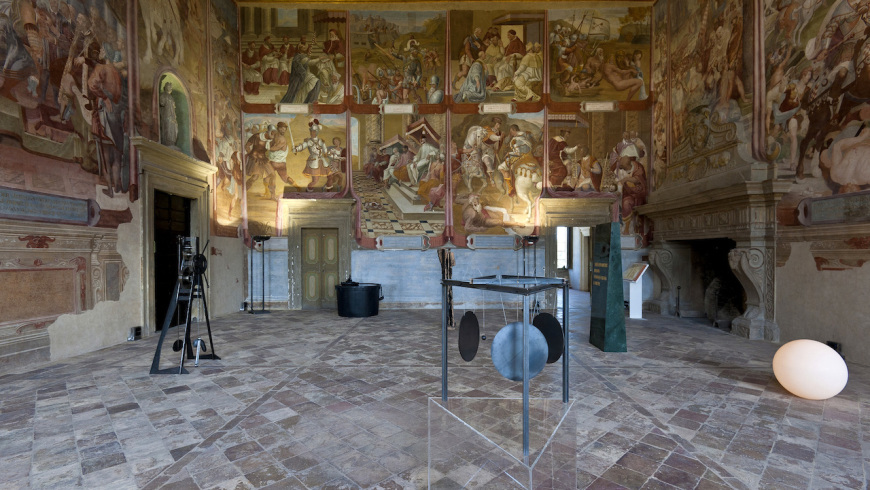
Max Ernst had put together 17 artists, in 1922, for his famous oil painting Au rendez-vous des amis, (190 x 135 cm. Now at the Museum Ludwig in Cologne). Bruno Corà, the irrepressible curator, critic and art historian has put together 66, always of artists, on 26th and 27th June 2015, for the event that, borrowing the title from Ernst, made Città di Castello the capital of the most diverse trends in contemporary art for two days.
The occasion? A double one: to celebrate the centenary of the birth of Alberto Burri, genius loci, and bring good wishes for a new life in the Palazzo Vitelli a Sant’Egidio, in the center of town, destined to become an important container of artistic events.
How? With a two-day conference at the Ex Seccatoi del Tabacco, known for its collection of paintings by the “centenary” artist displayed therein. Spaces turned into academy with 9 rectangular tables, handled by illustrious moderators (directors and curators of museums and galleries) come from all over Europe: Gabriella Belli (Fondazione Musei Civici of Venice, Italy); Laurent Busine (Musée des Arts Contemporains de Grand-Hornu, Belgium); Jean De Loisy (Palais de Tokyo, Paris, France); Rudi Fuchs (formerly Stedelijk Museum Amsterdam, Netherlands); Enver Hadziomerspahic (Ars Aevi Museum of Contemporary Art, Sarajevo, Bosnia-Herzegovina); Lorand Hegyi (Musée d’Art Moderne de Saint-Etienne, France); Magdalena Juríková (Galerie Hlavniho mesta Prahy, Prague, Czech Republic); Werner Meyer (Kunsthalle Göppingen, Germany); Angela Tecce (Castel Sant’Elmo, Naples, Italy); Denys Zacharopoulos (Macedonian Museum of Contemporary Art, Thessaloniki, Greece).
Artists, around the tables, on the first day of the meeting in small groups, had their say about the state of the art, about: nature; ethics; sacred; history and memory; science and technology; communication; market economics and finance; new cultures and new countries; development in the social context. And then, on the second day, they drew shareable conclusions, all together happily, in a successful and well coordinated cocktail of languages.
The numerous, avid and knowledgeable audience who attended the works in a hall of the Seccatoi linked to that of the speakers, fitted with modern and functional multimedia technologies through the intervention of efficient teams of simultaneous translators and video operators.
At the end of the conference there was the inauguration of the exhibition (a work by each artist invited) in the fascinating (and unknown to most) areas of the main floor of Palazzo Vitelli a Sant’Egidio. A miniature Palazzo Te, former home of the descendants of soldiers of fortune, with the calf in their coat of arms, allies, on and off, of the Medici, intimate with the Farnese, with Cesare Borgia (who had Vitellozzo executed, the best known of the family, as told by Niccolò Machiavelli) and with some Popes.
Those wealthy patrons of architecture and frescoes entrusted, among others, to Prospero Fontana the task of enhancing, in the main hall of their mansion, the glory of the military exploits of the Vitelli (a kind of ideal continuation of the work done by the same artist, along with Giorgio Vasari, for the Medici in the Palazzo Vecchio in Florence). Fontana executed the commission between 1572 and ’74. Some say too quickly to refine the details of the paintings. The hall is still a room of wonders that today, and until October 18th, 2015, serves as the setting for the works of some of the artists invited by Corà. The others can be seen in the adjoining rooms, not less impressive.
These are artists present:
Marco Bagnoli, Stephan Balkenhol, Gianfranco Baruchello, Bizhan Bassiri, Jean-Pierre Bertrand, Gianni Caravaggio, Lawrence Carroll, Enrico Castellani, Giuliana Cunèaz, Richard Deacon, Silvie Defraoui, Auke de Vries, Antonio Dias, Braco Dimitrijević, Bruna Esposito, Marco Gastini, Eugenio Giliberti, Giorgio Griffa, Jusuf Hadžifejzović, Abel Herrero, Shirazeh Houshiary, Paolo Icaro, Emilio Isgrò, Jan Jedlička, Magdalena Jetelová, Joseph Kosuth, Jannis Kounellis, Christiane Löhr, Sergio Lombardo, Luigi Mainolfi, Masbedo, Eliseo Mattiacci, Vittorio Messina, Maurizio Mochetti, Carmengloria Morales, Hidetoshi Nagasawa, Hermann Nitsch, Nunzio, Mimmo Paladino, Nakis Panayotidis, Claudio Parmiggiani, Paola Pezzi, Michelangelo Pistoletto, Lucio Pozzi, Luisa Protti, Renato Ranaldi, Franco Rasma, Giovanni Rizzoli, Bernhard Rüdiger, Remo Salvadori, Felix Schramm, Helmut Schweizer, Martin Schwenk, Anita Sieff, Santiago Sierra, Nedko Solakov, Giuseppe Spagnulo, Ettore Spalletti, Giuseppe Stampone, Marco Tirelli, Grazia Toderi, Costas Tsoclis, Alexandros Tzannis, Felice Varini, Eduard Winklhofer, Gilberto Zorio.
The catalogue and the conference records are expected in the autumn.
Palazzo Vitelli a Sant’Egidio
Piazza Garibaldi • Città di Castello (Perugia • Italia)
until October 18th, 2015 • from 11.00 to 19.00 • closed on Mondays
info 075 8559848